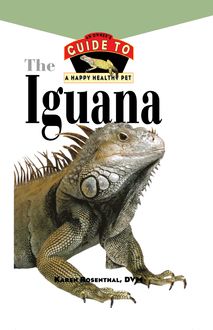The Gecko , livre ebook
87
pages
English
Ebooks
2009
Vous pourrez modifier la taille du texte de cet ouvrage
Obtenez un accès à la bibliothèque pour le consulter en ligne En savoir plus
Découvre YouScribe en t'inscrivant gratuitement
Découvre YouScribe en t'inscrivant gratuitement
87
pages
English
Ebooks
2009
Vous pourrez modifier la taille du texte de cet ouvrage
Obtenez un accès à la bibliothèque pour le consulter en ligne En savoir plus
Publié par
Date de parution
18 mai 2009
Nombre de lectures
0
EAN13
9780470493397
Langue
English
Poids de l'ouvrage
1 Mo
PART ONE: All About Geckos.
1. What Is a Gecko?
2. The History of Geckos.
PART TWO: Caring for Your Gecko.
3. Choosing Your Gecko.
4. Housing Your Gecko.
5. Feeding Your Gecko.
6. Your Gecko's Health.
PART THREE: Geckos Close-Up.
7. Types of Geckos.
8. Gecko Behavior.
PART FOUR: Beyond the Basics.
9. Gecko Conservation.
10. Recommended Reading and Resources.
Publié par
Date de parution
18 mai 2009
Nombre de lectures
0
EAN13
9780470493397
Langue
English
Poids de l'ouvrage
1 Mo
The
Gecko
Howell Book House
Howell Book House A Simon Schuster Macmillan Company 1633 Broadway New York, NY 10019-6785
Macmillan Publishing books may be purchased for business or sales promotional use. For information please write: Special Markets Department, Macmillan Publishing USA, 1633 Broadway, New York, NY 10019-6785.
Copyright 1999 by Howell Book House All rights reserved. No part of this book shall be reproduced, stored in a retrieval system, or transmitted by any means, electronic, mechanical, photocopying, recording, or otherwise without written permission from the publisher.
MACMILLAN is a registered trademark of Macmillan, Inc.
Library of Congress Cataloging-in-Publication Pavia, Audrey.
The Gecko / Audrey Pavia p. cm. - (An owner s guide to a happy healthy pet)
Includes bibliographical references
ISBN: 0-87605-212-X
1. Geckos as Pets. I. Title. II. Series.
SF459.G35P29 1998 639.3 95-dc21 98-35546 CIP
Manufactured in the United States of America 10 9 8 7 6 5 4 3 2 1
Series Director: Amanda Pisani Series Assistant Director: Jennifer Liberts Book Design: Michele Laseau Cover Design: Iris Jeromnimon Illustration: Steve Adams Photography:
Front cover by Bill Love; Inset photo by L. Puente; Back cover by Bill Love Joan Balzarini: 26 Zig Lesczcynski: 7, 8, 11, 13, 22, 23, 32, 34, 38, 41, 45, 46, 48, 50, 54, 55, 58, 60, 62, 66, 67, 70, 73, 74, 76, 78, 83, 86, 89, 90, 93, 95, 99, 100, 102, 106, 108, 111, 118 W. B. Love: i, 2-3, 5, 9, 16, 17, 25, 29, 33, 59, 64-65, 105, 109 Aaron Norman: 18, 20-21, 61, 81 L. Puente: 112, 119 David Schilling: 51 Judith Strom: 37 John Tyson: 43 B. Everett Webb: 35, 114, 122
Production Team: Carrie Allen, Ellen Considine, Kristi Hart, Clint Lahnen,
Dennis Sheehan, Terri Sheehan
Contents
part one
All About Geckos
1 What Is a Gecko?
2 The History of Geckos
part two
Caring for Your Gecko
3 Choosing Your Gecko
4 Housing Your Gecko
5 Feeding Your Gecko
6 Your Gecko s Health
part three
Geckos Close-Up
7 Types of Geckos
8 Gecko Behavior
part four
Beyond the Basics
9 Gecko Conservation
10 Recommended Reading and Resources
chapter 1
What Is a Gecko?
You ve seen a gecko somewhere, or maybe you already own one. That s why you are reading this book. There is something very special about geckos, something that draws us to them. Is it their wondrous colors and interesting patterns? Or could it be their unusual shape that sets them apart from other lizards? How about their calm and somewhat comical nature? Do we relate to it in some way? There is also a mystique inherent to geckos, and this is undoubtedly one of the things that fascinates us about them. As we watch them go about their daily lives, we can only wonder what goes on in their minds. Anyone who has observed a gecko for a period of time knows that there is a lot more to these intriguing animals than meets the eye.
Whatever our reasons for fascination with the gecko, there is one thing for certain: Living with one of these beautiful creatures enhances our lives and brings us closer to nature. While geckos won t interact with us like our pet dogs and cats do, they can still provide companionship in their own quiet and subtle way.
A Member of the Lizard Family
Geckos are part of the reptile class of vertebrates (animals with spines), and they have a number of things in common with their reptile cousins, namely snakes, turtles and other lizards. Like other reptiles, geckos have dry scales on their bodies. These scales are replaced regularly through the process of shedding, technically called ecdysis . Reptiles have very few-and in some cases no-glands in their skin.
The internal organs of reptiles are similar to those of humans and other mammals. For example, reptiles have a heart, lungs and a digestive system that aren t very different from our own.
Geckos belong to the lizard group, which is the largest group within the reptile class. There are nearly 5,000 different species of lizards in the world, living in the parts of the globe that are the warmest.
Lizards possess certain traits that set them apart from other reptiles. Most lizards have arms and legs, tails and body scales. Most lizard species also have eyelids (unlike snakes, which have none). Don t be misled, though: There are many geckos that are exceptions to this rule.
Geckos rank among some of the smallest lizards in the world. The Lipidoblepharis sanctaemartae gecko measures in at only around 1 inches long. The biggest gecko is Rhacodactyulus leachianus , which grows to a total of 14 inches long. By comparison, the largest modern lizard ever discovered is the Komodo Monitor ( Varanus komodoensis ), which can grow to be longer than 10 feet.
All Kinds of Geckos
There are around 700 different species of geckos in the world, each of which falls under one of four subfamilies within the larger Gekkonidae family: Eublepharinae, Diplodactylinae , Gekkoninae and Sphaerodactylinae . Only a handful of these many species are traditionally kept in captivity.
Geckos are found in great abundance throughout the world. In fact, only four species are considered as endangered or threatened. The Phelsuma guentheri, Sphaerodactylus micropithecus, Cyrtodactylus serpensinsula and Phelsuma edwardnewtoni geckos make up this short list and should never be sold as pets or captured.
Like other lizards, geckos produce eggs and have scales that they regularly shed. (Madagascar Giant Day Gecko)
In the United States, there are five native species, and about fifteen species that have been introduced to the U.S. environment. All of these geckos live in the southern portion of the country and can be found in California, Nevada, Arizona, New Mexico, Texas, Louisiana, Alabama, Georgia, Mississippi and Florida.
Geckos live in a variety of habitats. While all lizards dwell in the warmer areas of the world, geckos in particular live in temperate, tropical and subtropical climates. Geckos survive in both very humid environments and very dry ones. They make their homes in the rain forest, on high plateaus, in sandy deserts and even in human dwellings.
Gecko Details
You ve probably noticed that geckos look somewhat different from other lizards. This is because they have several distinctive traits.
Geckos have triangular-shaped heads and distinct necks. (African Fat-tailed Geckos)
H EAD
One of the easiest traits to spot is the construction of their head. Geckos tend to have a triangular-shaped head, while most other lizards have a more stream-lined, V-shaped head. The other lizards heads seem to flow right into their body. Geckos, however, usually have a discernible neck that attaches their unusual head to their body.
Some geckos have adhesive pads on their feet to help climb almost any suface. (Tokay Gecko)
F EET
The feet of many geckos have adhesive pads on their bottoms that allow the gecko to stick to just about any surface. Not all geckos have these pads, but the ones that do can hold on pretty tight when they want to-even when they are upside down.
T AIL
One of the gecko s most distinctive characteristics is its tail. Rather than being long and narrow as on other lizards, a gecko s tail is usually narrow at the base, thick in the middle and narrow at the tip. Unlike other lizards, many geckos use their tails to store fat for those times when food might be scarce. But just like other lizards, geckos are autotomous . That means they can detach their tails to distract predators. The detached tail will wiggle and writhe, keeping the predator from noticing that the best part of the meal is getting away.
The gecko s autotomous nature is one reason why it s so important to handle geckos carefully: Their tails are easily detached when they are roughly handled, even by well-meaning humans.
V OICE
Many gecko species are able to vocalize. Of those that can, the male gecko uses its voice to warn away intruders to its territory and also to attract a mate; the female can also produce sounds. This makes geckos a somewhat unique family in the lizard world because most other lizards are relatively silent.
In the daylight , nocturnal geckos pupils appear to be vertical slits; at night their pupils dilate to encompass nearly the entire eye. (Uroplatus lineatus)
EYES
The eyes of the gecko vary depending on the species. Most geckos are nocturnal (active mostly at night) and so have pupils that look like vertical slits when viewed in the daylight. These nocturnal geckos have very strong night vision, and their pupils will dilate to encompass nearly the entire eye. A few geckos are diurnal, meaning that they are most active during the day. These geckos have round pupils that look somewhat like ours.
The majority of gecko species don t have eyelids, which makes them similar to most other reptiles. However, some species of geckos-such as the Leopard Gecko-do have eyelids.
All geckos actually lick their eyeballs with their tongue. While scientists aren t completely sure why they do this, many suspect this is the gecko s way of keeping the eye area clean.
REPTILE SENSES
Although lizards and snakes are classified together in the superorder Squamata, their sensory abilities are quite different. Lizards, including geckos, have a well-developed sense of taste. Along with the ability to taste with their tongues, most lizards have what is known as a Jacobson s organ in their mouths. This feature, which they share with snakes, enables them to sense chemical traces in the environment. It almost provides them with a "sixth sense." Snakes rely very heavily on the information received through their Jacobson s organ, in large part because they have quite poor vision. They need the "extra sensors" to locate food. Lizards, in contrast, have good vision, and a strong sense of taste in their tongues. They also have the ability to hear quite well; whereas snakes are essentially deaf.
E ARS
Gecko ears are another fascinating part of t














